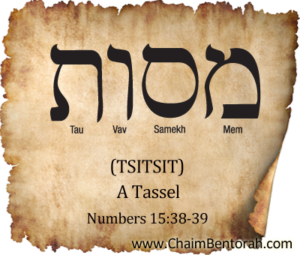HEBREW WORD STUDY – A TASSEL – TSITSIT ציצית Sade Yod Sade Yod Hei
HEBREW WORD STUDY – A TASSEL – TSITSIT ציצית Sade Yod Sade Yod Hei
Numbers 15:38-39: “Speak unto the children of Israel, and bid them that they make them fringes in the borders of their garments throughout their generations and that they put upon the fringe of the borders a ribband of blue: (39) And it shall be unto you for a fringe, that ye may look upon it, and remember all the commandments of the LORD, and do them; and that ye seek not after your own heart and your own eyes, after which ye use to go a whoring:”
 God commanded the Israelites to place fringes on the four corners of their garments. The word in Hebrew for fringes is tsitsit or a tassel. You find them on a tallit which is a fringed garment worn as a prayer shawl. The purpose was to remind the Jewish male of the commandments. Since the Israelites were forbidden to enter the Promised Land because of their lack of faith in God to protect them they got the idea that they did not need to obey the commandments. They thought the commandments only applied if they were going to live in the Promised Land. One poor soul decided to ignore the command to not work on the Sabbath and gathered some sticks Numbers 15:33. He got executed for this violation convincing everyone that the commandments were not a house warming gift for their settling in the Promised Land. Right after this, even God commanded that all Israelite males were to put tsitsit on the four corners of their garments so when they look upon it they will remember the commandments.
God commanded the Israelites to place fringes on the four corners of their garments. The word in Hebrew for fringes is tsitsit or a tassel. You find them on a tallit which is a fringed garment worn as a prayer shawl. The purpose was to remind the Jewish male of the commandments. Since the Israelites were forbidden to enter the Promised Land because of their lack of faith in God to protect them they got the idea that they did not need to obey the commandments. They thought the commandments only applied if they were going to live in the Promised Land. One poor soul decided to ignore the command to not work on the Sabbath and gathered some sticks Numbers 15:33. He got executed for this violation convincing everyone that the commandments were not a house warming gift for their settling in the Promised Land. Right after this, even God commanded that all Israelite males were to put tsitsit on the four corners of their garments so when they look upon it they will remember the commandments.
Would you like Chaim Bentorah as your personal Hebrew teacher?
|
|
Each tsitsit was to have a blue thread. We assume it was blue because there is no word in the Hebrew for blue. The Hebrew word used is techelet. Techelet was a specific dye used to dye wool. It was considered to be the dye of the rich as it was extremely expensive. The Talmud speaks of a dye that comes from a marine animal called a chillazon which appears once every seventy years as the source of this dye. Its blood ran a spectrum of deep red to violet but when exposed to light over a period of time it turned into a blue like the sky and sea. Hence it was considered a bluish color. It was striking because it was a color not usually seen since it was a rare color. As this marine animal appeared only every seventy years, the color was rare and also expensive so only a thread was required.
What is really interesting about this verse are the Hebrew words re’item ‘oto which is usually rendered as “you shall see it.” However, there is no neuter gender in Hebrew, just masculine and feminine. Since the blue thread is neither male nor female the translators simply render the pronoun as it which is perfectly grammatically correct if the intention was directed to a dead piece of thread. However, the sages teach that oto should be rendered in the masculine and read as “you shall see Him.” Talmud Berachot 1a. Thus, when you look upon the blue thread you are to see Him – God. “For the blue thread resembles the sea, the sea resembles the grasses, grasses resemble the sky and the sky resembles the Divine throne.”
Why did God command such a thing? The Talmud in Menachot 43a teaches that “sight brings on memory and memory brings deed.” This is followed by a story of a rich man who took the precept of the tsitsit very seriously. However, one day he heard of a certain harlot who was so beautiful that she charged four hundred gold coins. The rich man immediately sent a messenger with four hundred gold coins and set up an appointment. On the day of his appointment, he was ushered into the room of the harlot who sat on top of a bed that required the man to ascend a couple stairs. As he walked up the stairs he tripped and the four fringes of his garment with the blue thread struck him in the face. He immediately descended the stairs and announced he was leaving. The harlot demanded to know what blemish he saw in her that he did not desire her. He replied: “Never have I seen a more beautiful woman than you. But there is one precept which our God has commanded us, it is called the tsitsit and it expresses: ‘I am the Lord your God.’ The tsitsit has appeared to me as four witnesses to the act of adultery I was about to commit.” The story ends with the harlot surrendering her life to God and turning over her wealth through ill-gotten gain to the poor.
The verse concludes with, “you shall not seek after your own heart.” You see a believer who has given his heart to God will naturally want to serve God. You naturally want to please Him and do His will. But sometimes the heart gets a bit selfish and like the rich man, one will let his passions override his desire to serve God. When that happens there was a visual object, the tsitsit to remind one of his love for God, and his desire to do God’s will not his own.
I don’t recommend a Christian who is not Jewish to wear a tsitsit. If you are not Jewish don’t pretend to be one. Be what God created you to be, a gentile but that does not mean you cannot follow the example of the Jews. The law of the tsitsit applies to us but it does not have to require wearing a tassel. Some Christians wear a cross around their neck or carry a little cross in their pocket. This is not a talisman which is to have magical or supernatural powers to bring good fortune, it is as the scripture teaches a reminder that you do not seek after your own heart. Our hearts have been given to God but we tend to forget and we need a physical reminder of that. Whether it is a little cross around our neck, a Bible that we carry or a hat like I wear the purpose is to remind ourselves that we are always in the presence of God and whatever we do we do as unto God.
The enemy is always ready to distract us from our submission to God and God commands us to have physical reminders of our commitment to Him. Just as a wedding ring serves as a reminder that there is someone at home that you are committed to whenever you are tempted.
Hi there! Thank you for reading this Daily Word Study. Can I ask a favor? Share this Daily Word Study with your friends on Facebook and Twitter by clicking one of the icons below.
Thanks & Blessings, it means a lot to me!







Recent Comments